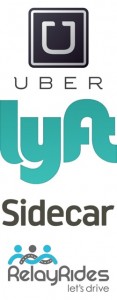Ride-Sharing Revs Up Around D.C., And Regulators May Not Even Freak Out Over It
 Barely a year and a half after the District of Columbia Taxicab Commission welcomed Uber to Washington, D.C., by arresting an Uber driver and impounding his car, the car-sharing economy in the nation’s capital rolls on in a higher gear.
Barely a year and a half after the District of Columbia Taxicab Commission welcomed Uber to Washington, D.C., by arresting an Uber driver and impounding his car, the car-sharing economy in the nation’s capital rolls on in a higher gear.
Uber has branched out from its black-car service to offer transportation via SUVs and, as of last week, taxi-priced “Uber X” hybrid sedans. You can look for a cheaper shared ride in a private vehicle from SideCar and, also as of last week, Lyft. As a driver, you can try to cash in on this trend by signing up with one of those two services–or you can make a little extra by renting your car to others through RelayRides.
(If you’re a student of disruptive innovation, Uber makes a fascinating case study: It’s flipped the usual playbook around by starting at the top of the value chain and has since been expanding its offerings into lower-value, wider markets.)
On top of such existing car-sharing options as ZipCar and the more flexible, point-to-point car2go–not to mention Metro, Capital Bikeshare and plain old walking–the case for solo ownership and occupancy of a car has never been weaker in D.C. A Washington Post survey found that 19 percent of District residents had used a car-sharing service.
And regulators may be taking note. The DCTC still doesn’t think too highly of the legality of UberX, SideCar and Lyft. But instead of leaving it at that, it’s refrained from staging new sting operations and now says it’s talking to ride-sharing services about ways to move them from what SideCar CEO Sunil Paul earlier called “not illegal” status to a recognized place in District regulations.
“The discussions regarding the ride sharing services are expected to lead within the next several weeks to a proposed regulation to address this service,” wrote DCTC spokesman Neville Waters. “The Commission holds no advanced fixed positions as to what is and what is not acceptable.”
“It’s starting to be more and more cooperative with local governments,” said Lyft co-founder John Zimmer Thursday, adding that “we’re learning how to best work with them to help solve their concerns about consumer protection.”
At the end of July, the California Public Utilities Commission announced plans for a new regulatory framework covering “Transportation Network Companies” that would codify many of the current practices of Lyft and SideCar, such as running background checks on drivers and providing them with extra insurance.
RelayRides may be an outlier here. It advertises cheap airport car rentals (although the vehicles it lists as being near National or Dulles can be tens of miles away) but has elected to bypass the Metropolitan Washington Airports Authority.
“Airports Authority regulations require the approval of, and appropriate permits for, any commercial activity on the airports, including Rental Cars, which peer-to-peer car sharing, like RelayRides, appears to be,” wrote MWAA spokesman Christopher Paolino. He said that San Francisco startup has not contacted the authority for any such approval.
In the Bay Area, however, RelayRides provides shuttle service between San Francisco International Airport and one offsite location and offered to pay the same fees to SFO as other car-rental services.
Winning a large base of satisfied and voting customers can do a lot to change attitudes in government. So can persuading those customers to call or e-mail their local elected representatives–Uber has been almost alarmingly effective at getting its users to swarm.
Seeing incumbent transportation providers stumble can also help companies looking to break open the market. In the District, conventional taxi service continues to lag–DCTC’s mandate to install credit-card readers in all cabs got pushed back yet again last month. Since the overdue demise of the District’s illogical, unfair zone-fare system in 2008, the only major upgrade to the taxi experience here has come from third-party apps (Uber’s included) that let you hail a cab and pay for the ride from a smartphone.
In the Bay Area, the brief BART strike over the July 4 holiday week made it imperative to use each car as efficiently as possible. Ride-sharing services earned some credit for helping to fill in during that stoppage of the region’s heavy-rail system and may get another chance to fill in, as BART and its unions still haven’t reached a deal.
And there’s also this underrated potential benefit of ride-sharing startups: By doing something that DMVs, politically speaking, can’t–refusing drivers without a clean record, or at worst more two moving violations over the last three years–they provide what could become a powerful incentive over time for people to drive smarter and safer.








